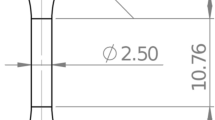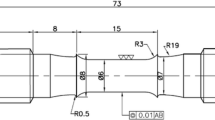Conclusions
-
1.
The reduction of the fatigue limit as the result of small plastic deformation of prepared fatigue samples occurs not only with deformation by tension but also by compression. The reduction of the fatigue limit depends on the atomic-crystalline structure of the metal. The larger reduction occurs in α titanium alloys with a hexagonal lattice and the smaller in bcc metals, with no reduction for fcc metals.
-
2.
For metals with a hexagonal lattice the fatigue limit begins to decrease with ε=1.5% and remains low up to ε=5.6%, while for bcc metals the fatigue limit is minimal after preliminary deformation of 1–3%. There is little change in the fatigue limit of fcc metals.
-
3.
Removal of a thin surface layer by etching or chemical polishing of prepared samples after preliminary deformation or tempering at 250°C does not restore the fatigue limit; tempering at 600 and 450° after preliminary deformation completely restores the fatigue limit.
-
4.
Small plastic deformation of blanks from which fatigue samples are prepared leads to a slight reduction of the fatigue limit. Evidently the condition of the surface layer changes in the process of preparing the fatigue samples, the hardening and residual stresses almost compensating the reduction of the fatigue limit that occurs in prepared samples subjected to preliminary deformation.
-
5.
The reduction of the fatigue limit as the result of small plastic deformation of prepared fatigue samples is explained by the occurrence of oriented residual microstresses — the “peak” microstresses in “weakened” microvolumes reduce the fatigue limit determined in standard fatigue tests regardless of the sign of the microstresses.
Similar content being viewed by others
Literature cited
N. I. Chernyak, Mechanical Properties of Steel in the Range of Small Deformations [in Russian], Izd. AN UkrSSR, Kiev (1962).
M. Ya. Gal'perin et al., Izv. Akad. Nauk SSSR, OTN, Mekhanika i Mashinostroenie, No. 3 (1961).
G. T. Nazarenko, Reports of the Fourth Conference on Fatigue of Metals [in Russian], Izd. IMET AN SSSR, Moscow (1966).
G. S. Pisarenko and B. S. Shul'ginov, Zavod. Lab., No. 6 (1966).
G. T. Nazarenko and I. I. Ishchenko, “The reduction of the fatigue strength of steel subjected to preliminary deformation,” Dokl. Akad. Nauk UkrSSR,5, No. 5 (1969).
V. A. Ingerma, Trudy Tallinskogo Politekhnicheskogo Inst., Ser. A, No. 219 (1965).
V. A. Zhukov and T. K. Marinets, in: Strength of Metals under Cyclic Loads [in Russian], Nauka, Moscow (1967).
A. V. Gur'ev et al., Izv. Akad. Nauk SSSR, Metally, No. 2 (1967).
E. M. Shevandin and N. S. Kaganovich, Sh. Tekh. Fiz.,10, No. 4 (1940).
L. A. Glikman and V. P. Tekht, in: Properties of Materials Used in Turbine Construction and Methods of Testing Them [in Russian], Mashgiz, Moscow-Leningrad (1962).
I. A. Oding and A. I. Efremov, Vestnik Metallopromyshlennosti, No. 10 (1931).
L. A. Glikman and N. N. Davidenkov, Zh. Tekh. Fiz.,21, No. 5 (1951).
Additional information
Leningrad Metallurgical Plant, Leningrad Institute of Precision Mechanics and Optics. Translated from Metallovedenie i Termicheskaya Obrabotka Metallov, No. 6, pp. 12–17, June, 1972.
Rights and permissions
About this article
Cite this article
Glikman, L.A., Feigin, L.M. Effect of small plastic deformation on the fatigue strength. Met Sci Heat Treat 14, 480–484 (1972). https://doi.org/10.1007/BF00648298
Issue Date:
DOI: https://doi.org/10.1007/BF00648298




